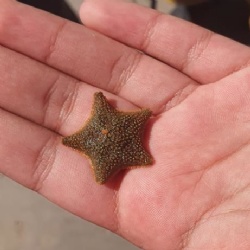Field trip To Dale Fort

As part of our A-level Biology course, we were given the amazing opportunity to travel to Dale Fort Field Studies Centre in Pembrokeshire, Wales. It was here that we were able to take part in extensive amounts of fieldwork on a number of different and unique shores, gaining practical skills and ecological knowledge from the resident FSC (Field Studies Council) staff.
Day 1
We arrived after a 5-hour journey in time for lunch in Dale village. We made our way on foot to Dale Fort shortly after which was a lovely walk to really take in the scenic views.
Our first lesson was an introduction and included: a briefing on safety, Dale Fort as a Field Studies Centre, and what to expect. After this, we made our way to the first beach - Jetty Beach (which is an exposed rocky shore). Here, we were given the opportunity to do a ‘rocky shore rummage’ and time to explore the marine organisms that inhabit these shores.




We had a lesson on the beach about the different species, including seaweeds and snails, that are present at different heights on the shore. Some groups found common shore crabs, Mrs Kenward found a brittle star and Anuva’s group found a blenny fish.


The first investigation involved counting the number of purple topshells and common topshells. This was conducted in the middle shore and upper shore which gave us data to perform a Chi squared statistics test back in the classroom.
In the evening, we had some downtime to  explore Dale Fort and the opportunity to go to The Point. This was a place that was on Dale which allowed us a whole view of the sea. Being very exposed to the elements, it was VERY cold and windy!
explore Dale Fort and the opportunity to go to The Point. This was a place that was on Dale which allowed us a whole view of the sea. Being very exposed to the elements, it was VERY cold and windy!
Day 2
We began the day with field work out on the field  behind Dale Fort, where we discussed the advantages of various sampling strategies such as random and systematic sampling in a homogenous environment. After this we walked to Dale village, whereupon arrival we settled down for lunch and were able to purchase ice creams in the local gift shop.
behind Dale Fort, where we discussed the advantages of various sampling strategies such as random and systematic sampling in a homogenous environment. After this we walked to Dale village, whereupon arrival we settled down for lunch and were able to purchase ice creams in the local gift shop.
At Dale Beach, we learnt about the capture-mark-recapture sampling method, and after a quick demonstration on how to identify sandhoppers, we got into groups to start capturing these jumpy organisms! The next job was to mark the sandhoppers with paint and then release them back into their habitat. After an hour we set about recapturing a second sample of sandhoppers so that we could use this data to estimate the population size using the Lincoln Index.




Afterwards we moved onto Black Rock further along Dale beach to complete a transect using the SACFOR abundance scale. This allowed us to collect data on the distribution and abundance of all shore species which we then used to produce a huge kite diagram graph.
Day 3
On the third day of our trip, we visited Castle Beach, a sheltered rocky shore. We collected data for the T-Test and Spearmans’ rank statistics tests. We measured the height and width of limpets using callipers so that we could investigate whether the ratios changed as height of the shore increased. We found that the size of limpets are statistically significantly larger in size higher up the shore. There are fewer desiccation factors affecting the limpets as there is less submersion caused by the tide higher up. Limpets are also taller on higher shore because they need to encapsulate water as there is less interaction with it naturally and this puts stress on their ‘foot’ (known as a radulla) which forces them to grow taller to support this.




After we gathered our data from Castle Beach, we swiftly made our way back to Dale Fort to start researching and planning methods for our individual projects. We used some authentic research articles from Dale Fort and books that they recommended in their on-site library. We had to decide which statistical test would be appropriate for the data we collected.


After all the planning, we had a lovely evening which involved a presentation to award prizes for those students who had gone ‘above and beyond’, including those who had shown excellent teamwork, asked the best questions, and who caught the most sandhoppers! There was also a video montage of all the photos from our trip which we all enjoyed, and it also gave us an opportunity to thank the excellent FSC staff and present them with chocolates and handmade thank you cards. The catering staff also baked a huge cake for two birthdays we celebrated on the trip which we all enjoyed after dinner!
Day 4
On Day 4 we were greeted with beautiful blue skies to complete our individual investigations. Having prepared our methods and planned what equipment we would need, we were able to set off early to our investigation sites and start data collection. We had to work quickly and efficiently as the tide was coming in!

We arrived back at Kendrick that evening feeling exhausted, but having made new friends, lots of great memories and having studied ecology in the most spectacular location. This trip enthused and inspired all of us in a much greater way than simply covering the specification.
Maryam, Jasmina, Sanika & Sashini - Year 13
